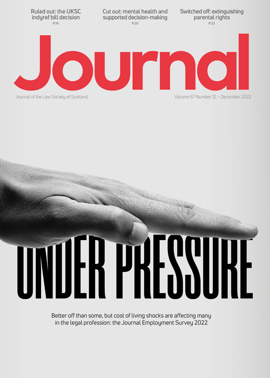Indyref: off limits for now
Aileen McHarg: The limits of legalism
 On 23 November, the Supreme Court delivered an unexpectedly decisive judgment on what the Lord Advocate described as the “festering issue”: whether Holyrood has the competence to legislate for an independence referendum: [2022] UKSC 31. The issue had been left unresolved by the political agreement, ahead of the 2014 vote, to temporarily amend the Scotland Act 1998 so as to put the lawfulness of that referendum beyond doubt.
On 23 November, the Supreme Court delivered an unexpectedly decisive judgment on what the Lord Advocate described as the “festering issue”: whether Holyrood has the competence to legislate for an independence referendum: [2022] UKSC 31. The issue had been left unresolved by the political agreement, ahead of the 2014 vote, to temporarily amend the Scotland Act 1998 so as to put the lawfulness of that referendum beyond doubt.
In the absence of similar agreement on the holding of another referendum post-Brexit, the Supreme Court held that the Lord Advocate was entitled to make a reference under paras 1(f) and 34 of sched 6 to the Scotland Act in order to resolve the legal question. The court also ruled that the proposed advisory referendum under the Draft Scottish Independence Referendum Bill unequivocally related to the reserved matters of the Union and the UK Parliament, and rejected the argument made by the SNP as interveners that the Scotland Act should be interpreted in light of the international law right to self-determination.
The procedural issue
The decision to accept the reference – before a bill had been introduced to Holyrood – was perhaps the most surprising aspect of the judgment. Other recent attempts to raise devolution disputes by creative routes have been firmly rejected (Keatings v Advocate General for Scotland [2021] CSIH 25; R (Counsel General for Wales) v Secretary of State for Business, Energy and Industrial Strategy [2022] EWCA Civ 118), and the Supreme Court had also previously refused to accept references by the Attorney General for Northern Ireland under the equivalent provision in the Northern Ireland Act 1998: [2019] UKSC 1; [2020] UKSC 2.
But the court’s approach to the procedural issue was actually consistent with its approach to the substantive vires issue. First, applying the now firmly cemented approach of interpreting the Scotland Act in the same way as any other statute, the words in sched 6, para 1(f) (“any other question arising by virtue of this Act about reserved matters”) were wide enough to cover the reference, and the court was not persuaded that any of the anomalies or potential alternative readings raised on behalf of the Advocate General for Scotland were sufficient to displace their plain meaning. Secondly, the court accepted the political importance of the question referred. In these circumstances, it would be contrary to the rule of law and the intention of the Scotland Act if the Law Officers’ potentially fallible judgment about the scope of devolved competences were to stop Holyrood from considering legitimate and politically important bills.
The court’s approach to the procedural issue is therefore one which endorses a strong role for legal advisers in the Scottish legislative process (see C McCorkindale and J Hiebert, “Vetting Bills in the Scottish Parliament for Legislative Competence” (2017) 21 Edin LR 319), but without allowing an excess of legal caution to inhibit the exercise of devolved legislative power.
The vires issue
The same approach produced a more predictable decision on the substantive question. In other words, whether a bill “‘relates to” reserved matters is determined by the test of purpose and effect: Scotland Act, s 29(3). Although “relates to” requires “more than a loose or consequential connection”, the court held that it was not restricted to considering only the direct or legal effects of bills. Even an advisory independence referendum would be an event of great political significance, irrespective of its outcome. The Lord Advocate could not therefore justify making the reference because of the “exceptional public importance” of the referendum question, while simultaneously downplaying its likely effect.
The self-determination issue
It was also predictable that the court would not accept that the Scottish people have a right to self-determination under international law. The court applied the distinction drawn by the Supreme Court of Canada, in the Quebec Secession Reference [1998] 2 SCR 217, between internal and external self-determination; only those groups denied meaningful internal self-determination enjoy a right to secede. This did not include the people of Quebec, nor by extension Scotland.
Here, though, the limits of the highly legalistic approach to devolution questions adopted by the court become apparent. In the Quebec case, the Canadian court went on to consider Quebec’s right to secede as a matter of domestic constitutional law, holding that the other provinces had a duty to negotiate if the Quebecois expressed a clear desire to become independent in response to a clear question.
The international law dimension clearly does not exhaust the constitutional discussion of self-determination in the UK context either. There is abundant political acceptance of Scotland’s right to become independent (including the fact of the 2014 referendum itself). Yet these broader constitutional understandings played no role whatsoever in the Supreme Court’s decision, and it had nothing positive to say about the process by which independence might be achieved.
Constitutional pathway to independence?
The decision therefore throws the independence debate firmly back into the political arena. There is no constitutional barrier to Scotland becoming independent, but no legal right to do so either. (See A McHarg, “Constitutional Law and Secession in the United Kingdom”, in A Pavkovic, P Radan and R Griffiths (eds), The Routledge Handbook of Self-Determination and Secession (forthcoming).) It is purely a matter of independence supporters exerting political pressure on the UK Parliament to agree to facilitate another referendum, or a more permanent recognition of Scotland’s right to secede on the model of the Northern Ireland Act 1998, or some alternative route to independence.
But while the decision does not positively shape that political process, it may do so negatively. First, there is a risk that political acceptance of Scotland’s right to self-determination becomes overshadowed by the court’s rejection of a legal right, just as the political importance of the Sewel Convention appears to have been undermined by its refusal to give it legal weight in Miller I [2017] UKSC 5. Secondly, attempts to constrain the Scottish Government’s expenditure on independence planning are reportedly now being considered. If these moves succeed, they will not only tip the political scales further in favour of supporters of the Union, but could have significant adverse effects on the workability of the devolution arrangements in Scotland and beyond.
Adam Tomkins: Now it’s for political judgment
 I confess to being doubly surprised by the Supreme Court’s ruling on the Lord Advocate’s reference. Not only did I think the court would rule that the reference had been made prematurely, but I also thought there was more room than the Justices found to accommodate an argument that a bill authorising a second independence referendum could be brought within Holyrood’s legislative competence.
I confess to being doubly surprised by the Supreme Court’s ruling on the Lord Advocate’s reference. Not only did I think the court would rule that the reference had been made prematurely, but I also thought there was more room than the Justices found to accommodate an argument that a bill authorising a second independence referendum could be brought within Holyrood’s legislative competence.
Evidently, I was wrong on both counts. Perhaps one day I will learn that seeking to predict Supreme Court rulings is a mug’s game!
Process ruling: untidy
Having reflected on the judgment, I still find the court’s rulings unpersuasive. This is particularly so on the process point. The Lord Advocate referred the matter under sched 6, para 34 to the Scotland Act. This provides that the Law Officers may refer a devolution issue (as defined) to the Supreme Court. The Advocate General for Scotland was of the view that this procedure could not be used to check the vires of legislation, for the reason that the Scotland Act has a different, well established process for doing exactly that.
Section 33 makes it plain that the Law Officers may refer legislation to the Supreme Court for a ruling on its competence after that legislation has been enacted by the Scottish Parliament (albeit before it has come into force). Here, the reference was made before legislation had even been introduced, never mind debated, amended, or passed. The Lord Advocate’s reference short-circuited the s 33 procedure and cut the Parliament out of the loop entirely.
That the court accepted the reference leaves the law “untidy” (as the court acknowledged: para 41). The sched 6, para 34 route can be used by Law Officers to challenge the vires of proposed bills, but not of actual bills which have been introduced into the Parliament (para 22). That’s the first untidiness. The second is that this route may be used to challenge proposed bills on the ground that they would relate to reserved matters, but not on the other grounds which delimit Holyrood’s legislative competence (for example, incompatibility with Convention rights).
Substance ruling: short shrift
So be it. As to the substance, when the question whether the Scottish Parliament could legislate for an independence referendum first emerged in 2012, I was certain it could not. Others, including my friend Professor McHarg, took a different view, more generous towards competence. In recent years I had come to reconsider my more hardline position, as I thought the Supreme Court’s rulings on aspects of the law of devolution undermined it. For example, in both Imperial Tobacco [2012] UKSC 61 and the Continuity Bill Reference [2018] UKSC 64, the court went out of its way to interpret reserved powers narrowly, maximising Holyrood’s room for legislative manoeuvre. Moreover, in Miller I [2017] UKSC 5 the court noted that the legal effect of the Brexit referendum was nil: it did not change the law.
Whether an Act of the Scottish Parliament relates to a reserved matter is to be determined by reference to its purpose, having regard to its effect in all the circumstances (Scotland Act, s 29(3)). Taking Imperial Tobacco, the Continuity Bill Reference and Miller I together, I thought it had become at least possible – indeed, plausible – to contend that, if the purpose of a referendum was simply to discover and record the opinion of the people of Scotland, and its effect was not to change the law in any way, then it could be ruled to be within the competence of the Scottish Parliament to legislate for such a referendum.
But in its judgment in Lord Advocate’s Reference the Supreme Court was having none of it. These arguments were given the shortest of shrift, with barely even a nod to what the court has said in past cases about purpose and effect.
Over to the politics
So where are we now? In one sense, nothing has changed. Everyone recognises and no one challenges that the ultimate decision-maker here is the people of Scotland. Since at least the time of Margaret Thatcher’s premiership, UK leaders have acknowledged and accepted that, if it is the settled will of the Scottish people to leave the United Kingdom, the UK state will not stand in their way.
What has changed, I suppose, is the mechanism by which we may test that “settled will”. Now it will be a political judgment, not a referendum, which assesses it. That is as it would have been in Thatcher’s day, and it is a reminder that, even after this judgment, it is in the political constitution and not in the courts of law that the final decision will rest.
Perspectives
Features
Briefings
- Criminal court: Farewell retrospective
- Agriculture: A future support framework
- Corporate: Is there a creditor duty?
- Intellectual property: "Reclaiming the UK statute book"
- Sport: Flouting their own rules?
- Succession: Crofting tenancy transfers in intestacy
- Scottish Solicitors' Discipline Tribunal: December 2022
- Property: Conveyancing – the future is in our hands
- In-house: With a fair wind






